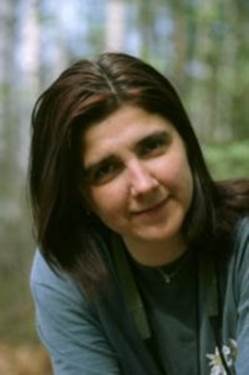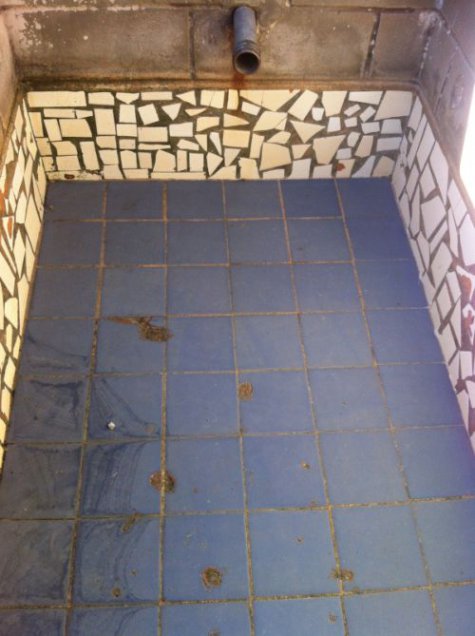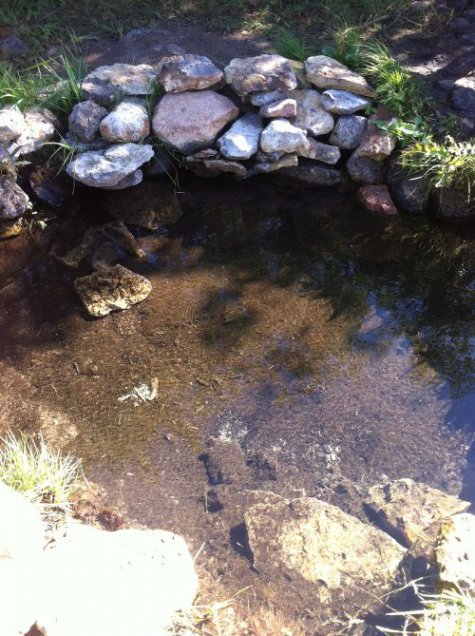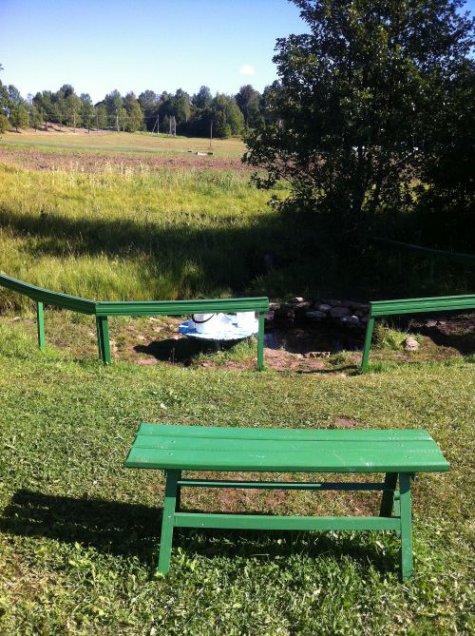When springs go dry...
Text and photos Kristel Vilbaste
Translation Liis
Congratulations to Kristel on her anniversary!
Sometimes you feel that now you have learnt all there is to know in life and experienced all but then some secret force is unleashed from a corner that you never even thought of.
The dried spring of Kuremäe
On Monday, August 17th, I hurried to Kuremäe, to delight my guests with the best and healthiest water in the world. And when I reached the spring with my water container and started to fill it with water from deep in the little tile-lined pond the surprise hit me. The spring was bone dry. Totally dry, not even a drop in the pipe mouth or in the bottom of the water basin, As dry as could be.
But how can such a powerful spring dry out? I have been coming to Kuremäe for 10 years, one-fifth of my life – fetching water for drinking and healing in winter frost and in summer drought, and always crystal clear water has been purling out of the pipe.
True, when I was writing my book “Eesti allikad – Estonian springs” in 2013 geologists told me that a 3-pronged pipe had been installed in the spring because during establishment of the quarry the spring had started to go dry. So at the time I investigated at some length the matters of who had put the pipe in the spring and when but this was so deeply secret that I never found an answer. Investigations made after the establishment of the quarry assured however that the quarry did not threaten the spring although it was only 3,5 kilometres away.
And there the matter remained.
But on Monday, walking around with my empty container I decided to investigate the matter more carefully.
A strange thing was that in the bathing house of the spring the water level was a little lower but the water as clear and refreshing as before. And when I took a bath for health with my mate Mikk Sarv I felt power streaming in, for tracking the story too.
It seemed most logical to go to the Kuremäe convent about the disappearance of the water. But since it was a hot day and I was dressed in shorts it seemed impolite to go and disturb the orthodox convent inhabitants with my unseemly dress code.
And then it all started to unroll like a fairytale when you get one piece of information from the first person that you meet whereupon you are sent to the next person to ask for the next piece.
The people in the shops always know best about springs and in the shop we got our first bit of information. The pleasant lady explained that the water really was in a pipe and that there was still a shortage of it every summer and this summer it had been simply turned off because people carried water off by large containerfuls and now there was not enough water even for the needs of the convent. But we should go and ask Mother Sidorova, who – look there! – precisely was busy over there in the cemetery.
We said our thanks and there among the triple crosses a nun in a brownish garb was in fact busy, just at the holy healing oak tree. I have always been a little shy of interviewing deeply religious people because I have been afraid of offending them unwittingly due to my own lack of knowledge, and they have also always felt so remote. The moment when the nun smiled at our question and started to talk about the spring was thus so much more astonishing. An affectionate devotion for people and the spring water showed in her every word.
Yes, she was the one to oversee the state of the cemetery and the spring. Yes, there was a pipe in the spring, and it was installed already in the time of Bishop Alexius when quarries were being established at Kuremäe in the Soviet era, because the convent heads then were afraid of being left without water. Through contacts geologists from Moscow and Siberia were brought in, and they put the always water-producing pipe into the spring and so secured the water flow. Just in case, a second well was drilled nearby. They had said that the water flows from some silvery layer. To start with the water had been measured every 10 days but then the measure-taker had died and the water level was only registered every third month because the well was closed with a very heavy lid.
To start with there was enough water but in summertime the water level falls dangerously low. This summer it was so low that water dribbled only sparingly into the spring and so the convent head asked for the tap to be turned off, and water was only provided occasionally now. But if we wanted water we would surely get it, but we had to go and talk to the convent head.
I looked again at my bare legs and decided to abstain from it, and said to the njn that we were as in a fairy-tale where one actoir sends one on to another for advice. And the nun said that yes, all life is like a fairytale. When she arrived here from Abachan in midwinter the whole convent was decked out in wonderful frost and so beautiful.
And she also told us a story that had actually happened in real life. One year, on the Kuremäe Day on August 24th, once again there was little water, but for the holy ceremony and the end of the Vasknarva procession they had filled the water containers with water by pails. But suddenly, the water started to flow at a great rate during those days, then decreased again until October. Everybody was amazed by this miracle. The drought usually lasts from July 1st until October.
But so that we would not go without water the nun directed us to the spring of the Twelve Apostles that was about 100 m downstream along the creek from the Kuremäe spring.
The spring of the Twelve Apostles
And really, where the nun directed us a spring, about a metre and a half across, glittered happily. All spring visitors fill their water containers from a large blue dipper. There was some floating plankton in the spring but the silvery upwelling spots were visible and the water tasted as good as that of the Kuremäe spring. Probaly it is a part of it.
Coming from the spring I felt a little baffled and called our limestone master Rein Einasto. He said that in Soviet times it was the practice to bring geology engineers from Siberia to Estonia, and our people went to Siberia so that all should be well hidden and properly muddled. And so there is so little information about the well pipe in the Kuremäe spring.
Rein also said that now is a bad year for springs because there have been two snowless winters and the melting snow is the greatest spring feeder. The arid summer has turned wells and springs dry in all Estonia. I told Rein that the information from Ain Kaha was all the more strange then, that in mid-summer water started to trickle from the long since dried up Pühaläte spring, at the Võhandu end. But Rein believed that when the outlets of the springs dried up this summer then the waters sought ways out in some unusual spots.
So with even more interest I now look forward to what more surprises the springs will offer this year. Go check the springs at your home. What do they tell you?












